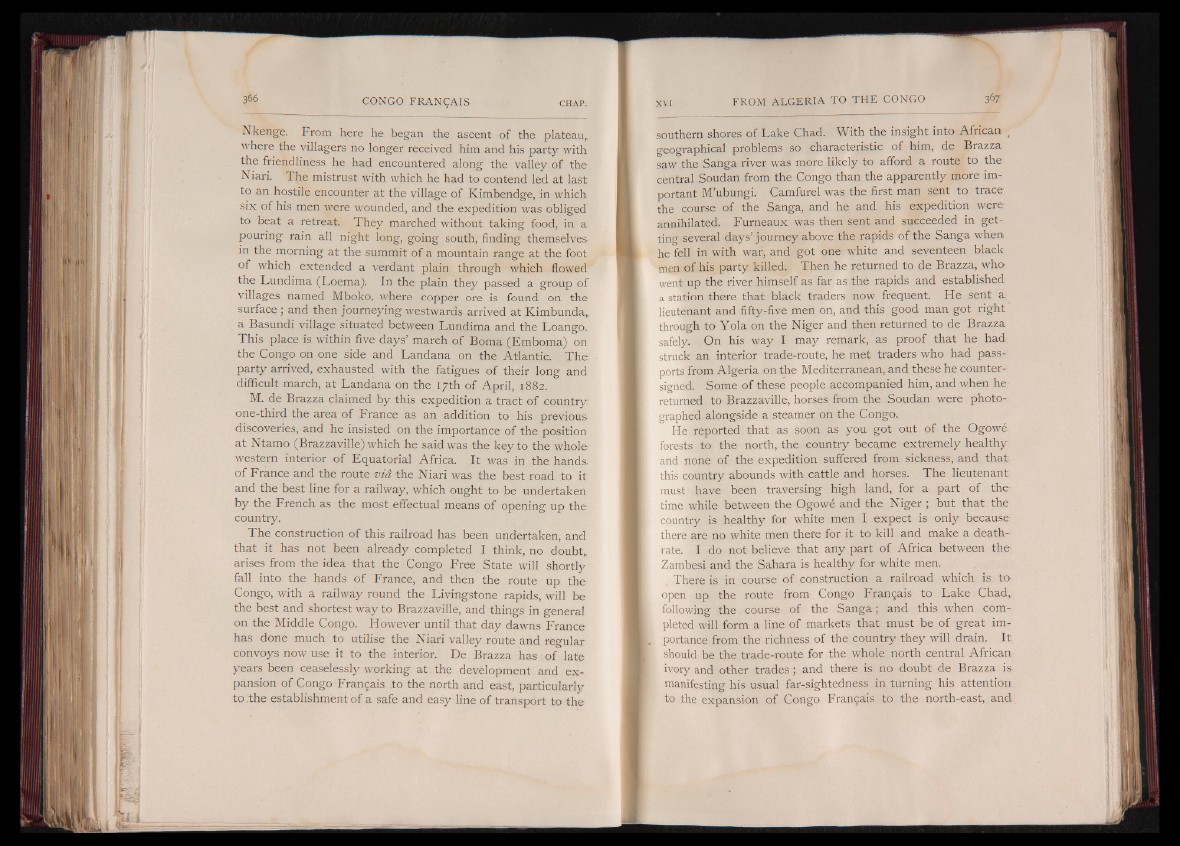
Nkenge. From here he began the ascent of the plateau,
where the villagers no longer received him and his party with
the friendliness he had encountered along the valley of the
Niari. The mistrust with which he had to contend led at last
to an hostile encounter at the village of Kimbendge, in which
six of his men were wounded, and the expedition was obliged
to beat a retreat. They marched without taking food, in a
pouring rain all night long, going south, finding themselves
in the morning at the summit of a mountain range at the foot
of which extended a verdant plain through which flowed
the Lundima (Loema). In the plain they passed a group of
villages named Mboko, where copper ore is found on the
surface ; and then journeying westwards arrived at Kimbunda,
a Basundi village situated between Lundima and the Loango.
This place is within five days’ march of Boma (Emboma) on
the Congo on one side and Landana on the Atlantic. The
party arrived, exhausted with the fatigues of their long and
difficult march, at Landana on the 17th of April, 1882.
M. de Brazza claimed by this expedition a tract of country
one-third the area of France as an addition to his previous
discoveries, and he insisted on the importance of the position
at Ntamo (Brazzaville) which he said was the key to the whole
western interior of Equatorial Africa. It was in the hands
of France and the route viâ the Niari was the best road to it
and the best line for a railway, which ought to be undertaken
by the French as the most effectual means of opening up the:
country.
The construction of this railroad has been undertaken, and
that it has not been already completed I think, no doubt,
arises from the idea that the Congo Free State will shortly
fall into the hands of France, and then the route up the
Congo, with a railway round the Livingstone rapids, will be
the best and shortest way to Brazzaville, and things in general
on the Middle Congo. However until that day dawns France
has done much to utilise the Niari valley route and regular
convoys now use it to the interior. De Brazza has , of late
years been ceaselessly working at the devèlopment and e x pansion
of Congo Français .to the north and east, particularly
to .the establishment of a safe and easy line of transport to the
southern shores of Lake Chad. With the insight into African ,
geographical problems so characteristic of him, de Brazza,
saw the Sanga river was more likely to afford a route to the
central Soudan from the Congo than the apparently more important
M’ubungi. Camfurel was the first man sent to trace
the course of the Sanga, and he and his expedition were
annihilated. Furneaux was then sent and succeeded in getting
several days’ journey above the rapids of the Sanga when
he fell in with war, and got one white and seventeen black
men of his party killed. Then he returned to de Brazza, who-
went up the river himself as far as the rapids and established
a station there that black traders now frequent. He sent a.
lieutenant and fifty-five men on, and this good man got right
through to Yola on the Niger and then returned to de Brazza
safely. On his way I may remark, as proof that he had
struck an interior trade-route, he met traders who had passports
from Algeria on the Mediterranean, and these he countersigned.
Some of these people accompanied him, and when he.
returned to Brazzaville, horses from the Soudan were photographed
alongside a steamer on the Congo,
He reported that as soon as you got out of the Ogowé
forests to the north, the country became extremely healthy
and none of the expedition suffered from sickness, and that
this country abounds with cattle and horses. The lieutenant
must have been traversing high land, for a part of the
time while between the Ogowé and the Niger ; but that the
country is healthy for white men I expect is only because
there are no white men there for it to kill and make a death-
rate. I do not believe that any part of Africa between the
Zambesi and the Sahara is healthy for white men.
There is in course of construction a railroad which is to-
open up the route from Congo Français, to Lake Chad,
following the course of the Sanga ; and this when completed
will form a line of markets that must be of great importance
from the richness of the country they will drain. It
should be the trade-route for the whole north central African-
ivory and other trades ; and there is no doubt de Brazza is
manifesting his usual far-sightedness in turning his attention
to the expansion of Congo Français to the north-east, and.